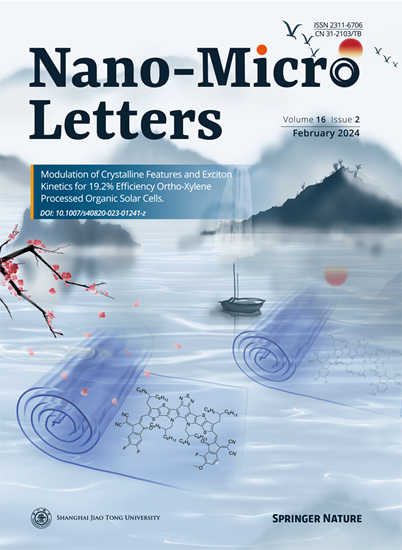倾斜超表面纳米结构的电场驱动生成纳米印迹。
IF 36.3
1区 材料科学
Q1 Engineering
引用次数: 0
摘要
倾斜超表面纳米结构具有优异的物理性能和巨大的应用潜力,对其制造方法提出了迫切的要求。本文提出了电场驱动的生成纳米印迹技术。施加在模板和基板之间的电场驱动接触、倾斜、填充和保持过程。通过精确控制柔性模板与衬底之间引入的夹角,可以将具有可控角度的倾斜纳米结构印印到衬底上,尽管它们在模板上是垂直的。通过灵活调节电场强度和夹角,可以制备出大面积均匀倾斜、梯度倾斜和大角度倾斜的纳米结构。与传统的复制相比,纳米印迹结构的形态扩展到定制控制。这项工作为制造各种大面积倾斜超表面结构提供了一种经济、高效和通用的技术。本文制作了一种具有高耦合效率的倾斜纳米光栅,并将其集成到增强现实显示器中,显示出优异的成像质量。本文章由计算机程序翻译,如有差异,请以英文原文为准。
Electric-Field-Driven Generative Nanoimprinting for Tilted Metasurface Nanostructures.
Tilted metasurface nanostructures, with excellent physical properties and enormous application potential, pose an urgent need for manufacturing methods. Here, electric-field-driven generative-nanoimprinting technique is proposed. The electric field applied between the template and the substrate drives the contact, tilting, filling, and holding processes. By accurately controlling the introduced included angle between the flexible template and the substrate, tilted nanostructures with a controllable angle are imprinted onto the substrate, although they are vertical on the template. By flexibly adjusting the electric field intensity and the included angle, large-area uniform-tilted, gradient-tilted, and high-angle-tilted nanostructures are fabricated. In contrast to traditional replication, the morphology of the nanoimprinting structure is extended to customized control. This work provides a cost-effective, efficient, and versatile technology for the fabrication of various large-area tilted metasurface structures. As an illustration, a tilted nanograting with a high coupling efficiency is fabricated and integrated into augmented reality displays, demonstrating superior imaging quality.
求助全文
通过发布文献求助,成功后即可免费获取论文全文。
去求助
来源期刊

Nano-Micro Letters
NANOSCIENCE & NANOTECHNOLOGY-MATERIALS SCIENCE, MULTIDISCIPLINARY
CiteScore
32.60
自引率
4.90%
发文量
981
审稿时长
1.1 months
期刊介绍:
Nano-Micro Letters is a peer-reviewed, international, interdisciplinary, and open-access journal published under the SpringerOpen brand.
Nano-Micro Letters focuses on the science, experiments, engineering, technologies, and applications of nano- or microscale structures and systems in various fields such as physics, chemistry, biology, material science, and pharmacy.It also explores the expanding interfaces between these fields.
Nano-Micro Letters particularly emphasizes the bottom-up approach in the length scale from nano to micro. This approach is crucial for achieving industrial applications in nanotechnology, as it involves the assembly, modification, and control of nanostructures on a microscale.
 求助内容:
求助内容: 应助结果提醒方式:
应助结果提醒方式:


